A sty (sometimes spelled stye) is a tender, painful red bump located at the base of an eyelash or under or inside the eyelid. A sty results from a localized infection of the glands or a hair follicle of the eyelid. The medical term for a sty is hordeolum (plural, hordeola).
The term external hordeolum refers to a sty that develops at the base of an eyelash (the hair follicle), whereas the term internal hordeolum refers to a sty that develops in a meibomian gland, a gland located on the underside of the eyelid that secretes an oily substance onto the eyeball.
A sty is sometimes confused with a chalazion (see below), which is a cyst or a specific type of scarring due to chronic inflammation arising in the meibomian glands of the eyelid. A chalazion may develop when the infection of a sty persists over time, resulting in scarring around the meibomian gland. In contrast to a sty, a chalazion is usually painless.
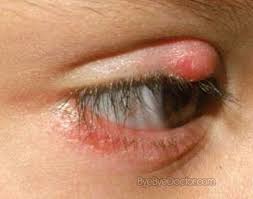

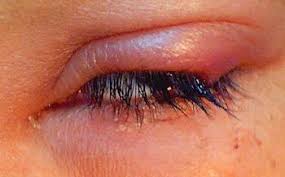
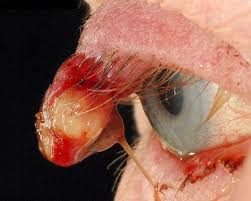
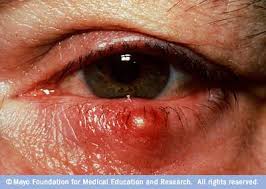
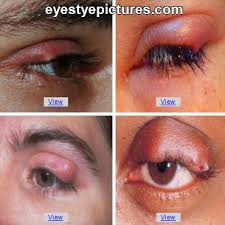
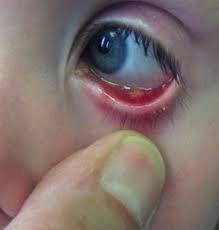
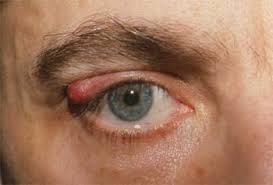
A sty results from an infection of the oil glands of the eyelid (meibomian glands) that help to lubricate the eyeball. The infection occurs after these glands have become clogged. A sty also may arise from an infected hair follicle at the base of an eyelash. The bacterium Staphylococcus aureus that is frequently found on the skin is responsible for 90%-95% of cases of styes. A sty also can develop as a complication of diffuse inflammation of the eyelid (blepharitis).
The first signs and symptoms of a sty are usually redness, tenderness, and pain in the affected area. The eye may feel irritated or "scratchy." Later signs and symptoms may include swelling, discomfort during blinking of the eye, watering of the eye, and sensitivity to light. A common sign of a sty is a small, yellowish spot at the center of the bump that represents pus rising to the surface
A sty is diagnosed by its characteristic appearance and symptoms. No other tests are necessary to establish the diagnosis of a sty.
Styes are very common. People of all ages can develop a sty, and men and women are equally affected. There is a slight increase in the incidence of styes during the third to fifth decades of life. People with certain chronic conditions (diabetes mellitus, chronic blepharitis [inflammation of the eyelid], seborrhea, and chronic debilitating illnesses) are more prone to develop styes than the general population. In many susceptible people, stress seems to trigger the development of a sty. Studies have shown that those who have high levels of blood lipids (fats) are more susceptible to blockages in the oil glands, including the glands of the eyelid and are, therefore, more likely to develop a sty.
homeopathic treatment
The term external hordeolum refers to a sty that develops at the base of an eyelash (the hair follicle), whereas the term internal hordeolum refers to a sty that develops in a meibomian gland, a gland located on the underside of the eyelid that secretes an oily substance onto the eyeball.
A sty is sometimes confused with a chalazion (see below), which is a cyst or a specific type of scarring due to chronic inflammation arising in the meibomian glands of the eyelid. A chalazion may develop when the infection of a sty persists over time, resulting in scarring around the meibomian gland. In contrast to a sty, a chalazion is usually painless.
What is the cause of a sty?
A sty results from an infection of the oil glands of the eyelid (meibomian glands) that help to lubricate the eyeball. The infection occurs after these glands have become clogged. A sty also may arise from an infected hair follicle at the base of an eyelash. The bacterium Staphylococcus aureus that is frequently found on the skin is responsible for 90%-95% of cases of styes. A sty also can develop as a complication of diffuse inflammation of the eyelid (blepharitis).
What are sty symptoms and signs?
The first signs and symptoms of a sty are usually redness, tenderness, and pain in the affected area. The eye may feel irritated or "scratchy." Later signs and symptoms may include swelling, discomfort during blinking of the eye, watering of the eye, and sensitivity to light. A common sign of a sty is a small, yellowish spot at the center of the bump that represents pus rising to the surface
How is a sty diagnosed?
A sty is diagnosed by its characteristic appearance and symptoms. No other tests are necessary to establish the diagnosis of a sty.
Who is most susceptible to the development of a sty?
Styes are very common. People of all ages can develop a sty, and men and women are equally affected. There is a slight increase in the incidence of styes during the third to fifth decades of life. People with certain chronic conditions (diabetes mellitus, chronic blepharitis [inflammation of the eyelid], seborrhea, and chronic debilitating illnesses) are more prone to develop styes than the general population. In many susceptible people, stress seems to trigger the development of a sty. Studies have shown that those who have high levels of blood lipids (fats) are more susceptible to blockages in the oil glands, including the glands of the eyelid and are, therefore, more likely to develop a sty.
homeopathic treatment
Pulsatilla 30 : An excellent remedy for styes, especially affecting the upper eye-lid, with burning and itching. There may be a discharge of profuse thick, yellowish mucous from the eye. A weeping nature and thirstlessness are other features of this medicine.
Silicea 30 : A remedy which can hasten the resolution of the stye, by bursting it open. A feeling of chill (making the person wear warm clothes even in summer), obstinate constipation and a desire for cold foods/drinks are other pointers to this remedy.
Staphisagria 30 : For recurrent styes that come one after another and leave behind hard nodes. This remedy can be tried if Pulsatilla fails.
Sul 30 : A good medicine to start the, treatment of a person with recurrent styes and an unhealthy skin. There is heat and burning in the eyes. A disinclination to stand and acute, unbearable hunger at 11 a.m. are other features of this remedy.

 10:06
10:06
 Dr. Ajay Srivastava
Dr. Ajay Srivastava
 Posted in
Posted in 
No Response to "sty??homeopathic treatment"
Post a Comment